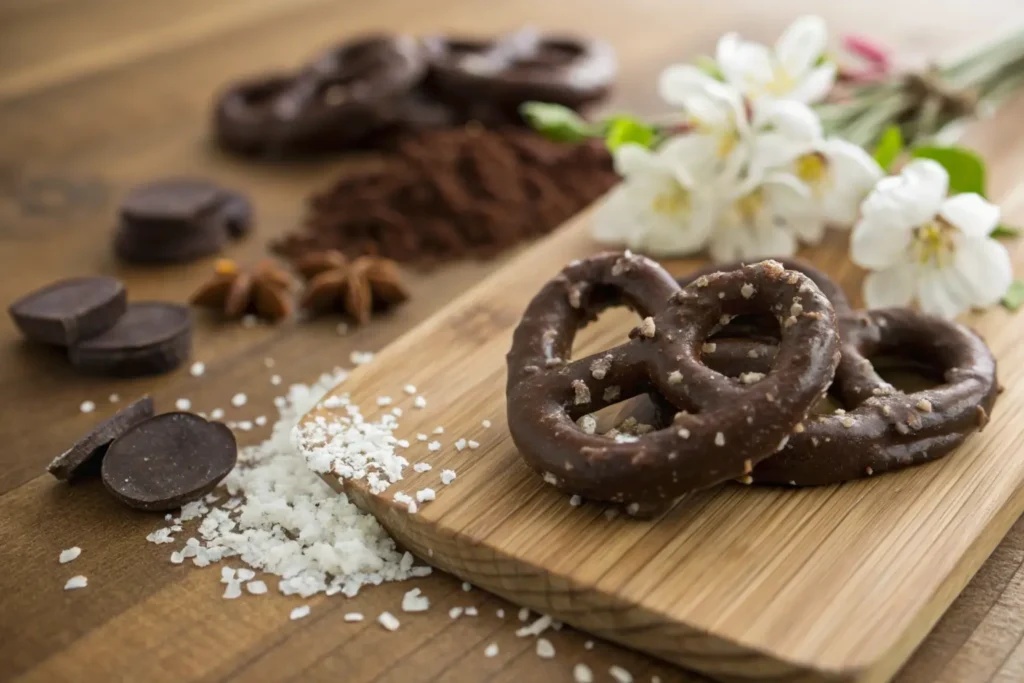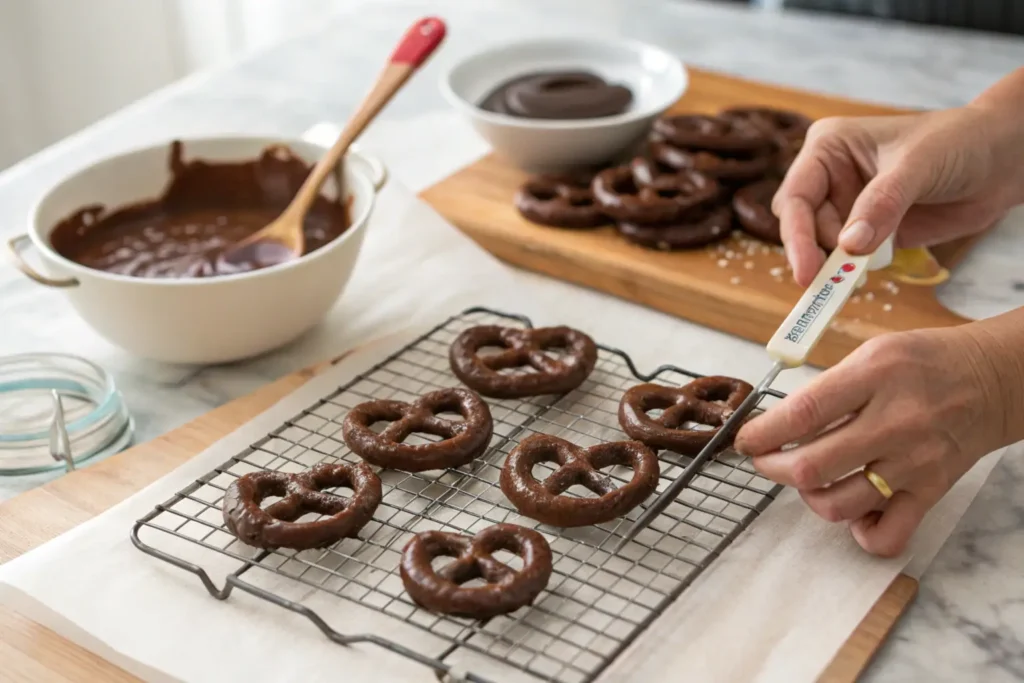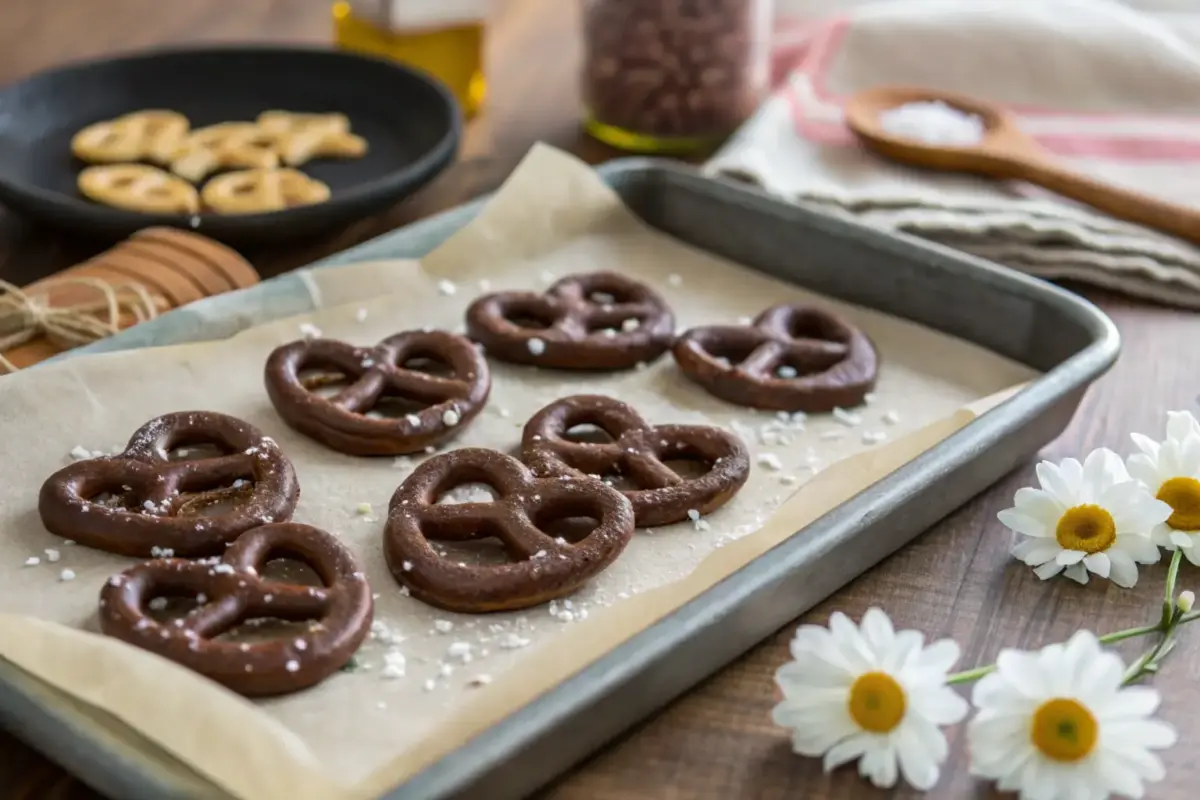Introduction to the Problem
Have you ever opened a bag of homemade chocolate-covered pretzels, only to find a weird white coating on them? It’s frustrating, right? You might think the chocolate has gone bad, but that’s not exactly what’s happening. This common issue, known as chocolate bloom, is more about the science of chocolate than its expiration date. Let’s break it down so you can avoid this problem in the future. For insights into making your chocolate-dipped treats perfect, check out How to Make White Chocolate for Dipping.
What Causes Chocolate to Turn White?

That chalky, white layer is usually a result of improper storage or handling. While it might look unappetizing, the good news is that it’s totally safe to eat. The whiteness occurs because of two main reasons: fat bloom and sugar bloom. Both have to do with how chocolate reacts to temperature and moisture. But don’t worry—we’ll go into detail about these causes in a bit. You might also find inspiration from similar recipes like White Chocolate Covered Pretzels.
Types of White Film on Chocolate
Fat Bloom: A Common Culprit
Fat bloom is one of the most common reasons your chocolate-covered pretzels might develop a chalky white layer. It usually happens when the chocolate experiences temperature changes. For example, if your pretzels were stored in a warm spot and then cooled down quickly, the fats in the chocolate can migrate to the surface, creating that unsightly bloom. The good news? It’s completely avoidable with proper storage.
Sugar Bloom: The Role of Moisture
Sugar bloom is caused by exposure to moisture. If your chocolate-covered pretzels are stored in a humid environment or experience condensation from the fridge, the water dissolves the sugar on the surface. When the moisture evaporates, it leaves behind a gritty white coating. This is why it’s crucial to keep your chocolate-covered pretzels dry during and after preparation.
Causes of Chocolate Bloom
Temperature Fluctuations During Storage
One of the biggest culprits behind chocolate bloom is temperature swings. Let’s say you store your chocolate-covered pretzels near the oven or a sunny window—oops! That heat can cause the chocolate to soften and the fats to separate. Later, when the temperature drops, those fats rise to the surface, leaving that dreaded white layer.
Improper Cooling After Dipping
When you’re making chocolate-covered pretzels at home, cooling them the right way is key. If you stick them straight into the fridge or freezer, the quick temperature change can cause condensation. And you know what that means—sugar bloom! Instead, let them cool at room temperature before storing them properly.
The Role of Humidity in Chocolate Storage
Humidity is another sneaky factor. High moisture in the air can wreak havoc on your chocolate. If you live in a humid area, even the best storage practices might not be enough. Using airtight containers with silica gel packs can help keep your chocolate fresh and free from bloom.
By now, you’re probably starting to see how temperature and moisture are the main villains in this chocolate mystery.
Understanding the Science Behind Chocolate Bloom
How Fat Bloom Develops at a Molecular Level
Let’s get a little geeky for a second—don’t worry, it’s easier than it sounds! Fat bloom happens because cocoa butter, the fat in chocolate, is super sensitive to temperature. When chocolate is exposed to heat, the fat melts and re-solidifies in uneven layers as the temperature drops. This process causes the fat crystals to rise to the surface, creating that dull white film. If you’re curious about how different techniques affect confections, explore related insights in What Is the Difference Between New York Cheesecake and Italian Cheesecake?.
The Chemistry of Sugar Bloom
Sugar bloom, on the other hand, is all about water. When chocolate comes into contact with moisture, like condensation from the fridge, the sugar dissolves. As the water dries up, the sugar re-crystallizes on the surface. This is why chocolate stored in humid environments is especially prone to this type of bloom. It’s like leaving saltwater out in the sun—the water evaporates, but the salt is still there.
Preventing White Film on Chocolate-Covered Pretzels

Importance of Proper Chocolate Tempering
Here’s the thing about tempering chocolate: it’s not just for fancy chocolatiers. Tempering aligns the fat crystals in chocolate so they stay stable, even when the temperature fluctuates a bit. It might sound intimidating, but you can do it at home with a thermometer and some patience. Melt your chocolate to around 110°F, cool it down to 80°F, and then gently reheat it to about 88–90°F. This process locks in the shine and snap, and best of all, it helps prevent bloom.
Ideal Storage Conditions for Chocolate Pretzels
Once your pretzels are dipped and ready to go, where you store them matters just as much as how you make them. Aim for a cool, dry place with a consistent temperature between 60–68°F. Avoid the fridge unless absolutely necessary, as the humidity can lead to sugar bloom. If you must refrigerate them, place the pretzels in an airtight container with a paper towel to absorb any moisture.
Maintaining Optimal Temperature
Temperature control is probably the biggest game-changer when it comes to storing chocolate. Sudden shifts—like moving chocolate from a hot kitchen to a chilly basement—can cause blooming. Keep the storage area steady, and remember: the cooler, the better.
Controlling Humidity Levels
If you’re in a humid area, silica gel packs are your best friend. These handy little packets absorb moisture and help keep your chocolate dry. You can also use airtight containers to create a barrier against humidity. It might feel like overkill, but trust me, your chocolate-covered pretzels will thank you.
Best Practices for Preparing Chocolate-Covered Pretzels
Choosing the Right Chocolate for Dipping
Not all chocolate is created equal, especially when it comes to dipping. High-quality chocolate with a good cocoa butter content is less likely to bloom compared to lower-quality alternatives. Look for couverture chocolate—it’s made specifically for melting and dipping and will give you a smoother, shinier finish.
Techniques for Properly Melting Chocolate
Melting chocolate might seem easy, but there’s a bit of finesse involved. Use a double boiler or microwave in short bursts to avoid overheating. If the chocolate gets too hot, the fats can separate, making it more prone to blooming later on. Stir constantly to distribute the heat evenly, and stop as soon as the chocolate is melted.
Cooling Techniques to Avoid Bloom
After dipping your pretzels, let them cool at room temperature for the best results. Rushing the cooling process by placing them in the fridge or freezer can cause condensation, leading to sugar bloom. If you’re short on time, use a fan to speed up air circulation while keeping the chocolate at a stable temperature.
By following these tips, you can say goodbye to chalky, white-coated pretzels and hello to perfectly glossy treats.
Myths About Chocolate Turning White
Is White Chocolate Bloom Unsafe to Eat?
One of the most common questions people ask is whether bloomed chocolate is still safe to eat. The answer is yes! That white film might look unappealing, but it’s harmless. Whether it’s fat bloom or sugar bloom, the chocolate hasn’t gone bad—it’s just undergone a cosmetic change. So, go ahead and enjoy your chocolate-covered pretzels, even if they don’t look perfect.
Debunking Common Misconceptions
Another myth is that chocolate bloom only happens with cheap chocolate. While quality does play a role, even the finest chocolate can bloom if it’s stored improperly. Similarly, some people think refrigerating chocolate will always keep it fresh. Unfortunately, the high humidity in most fridges can actually cause sugar bloom, leaving you with a chalky mess instead of a shiny finish.
How to Fix Chocolate That Has Turned White
Can Bloomed Chocolate Be Restored?
If your chocolate-covered pretzels have bloomed, don’t panic! While you can’t completely undo the bloom, you can melt the chocolate down and re-temper it. This process realigns the fat crystals and restores the chocolate’s glossy finish. Just melt it carefully, temper it as described earlier, and re-dip your pretzels if needed.
Using Bloomed Chocolate in Recipes
If re-tempering feels like too much work, you can always use bloomed chocolate in recipes where appearance doesn’t matter. Melt it down and use it for baking, making hot chocolate, or drizzling over desserts. Nobody will notice the difference, and you’ll still get that delicious chocolate flavor.
Alternative Treats to Chocolate-Covered Pretzels
Substitutes for Chocolate Coating
If you’re tired of dealing with chocolate bloom, consider using alternatives like yogurt or peanut butter coatings. These options are easier to work with and less sensitive to temperature and humidity changes. Plus, they add a fun twist to your pretzels!
Creative Ways to Repurpose Chocolate Pretzels
If your pretzels have bloomed, don’t toss them out! Crumble them up and use them as a topping for ice cream, mix them into trail mix, or turn them into a crunchy layer for cakes and pies. A little creativity can go a long way in giving those imperfect pretzels a second life.
FAQs
How do you keep chocolate from turning white when dipping?
The key is proper tempering and cooling. Tempering stabilizes the fat crystals in the chocolate, while gradual cooling prevents condensation that causes sugar bloom. Always work in a dry, cool environment for the best results.
Why are my chocolate-covered pretzels white?
The white film is likely chocolate bloom, caused by either fat rising to the surface (fat bloom) or sugar crystallizing due to moisture (sugar bloom). It’s usually a sign of improper storage or sudden temperature changes.
Is it safe to eat chocolate that turns white?
Yes, it’s completely safe to eat! Chocolate bloom doesn’t affect the taste or safety of the chocolate. It’s just a cosmetic issue, so go ahead and enjoy your treats.
How do you store chocolate so it doesn’t turn white?
Store chocolate in a cool, dry place with a consistent temperature between 60–68°F. Use airtight containers to keep out humidity, and avoid exposing the chocolate to sudden temperature changes.
Conclusion
In summary, keeping your chocolate-covered pretzels free from that frustrating white film is all about understanding chocolate bloom and taking a few simple precautions. Proper tempering, stable storage conditions, and attention to temperature and humidity can make all the difference. Remember, chocolate bloom, whether it’s fat bloom or sugar bloom, doesn’t mean your treats are unsafe to eat—it’s purely a cosmetic issue. By using high-quality chocolate and following best practices, you can achieve glossy, professional-looking pretzels every time. So, whether you’re prepping for a holiday party or just indulging in a sweet snack, these tips will help you avoid bloom and enjoy your chocolate treats at their best!

